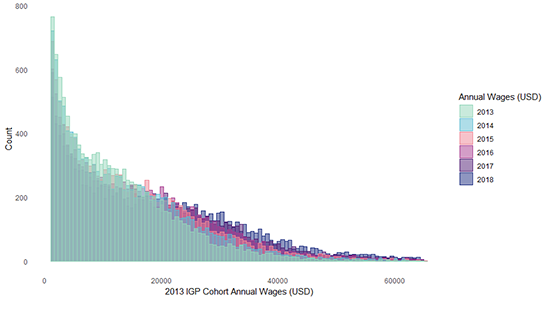Longitudinal Intergenerational Poverty Research Release
Kelsey Martinez, UDRC Manager
December 15, 2020

The intergenerational poverty (IGP) research conducted each year in Utah is spearheaded by the Intergenerational Welfare Reform Commission, a collaborative effort made by many agencies. Other agencies that contributed to the research effort in 2020 include the Utah Dept. of Health (UDOH), Dept. of Human Services (DHS), the Utah State Board of Education (USBE), and the Utah System of Higher Education (USHE) (link to Nune’s executive summary). UDRC produced Workforce Service’s (DWS) report. Members of the research subcommittee provided useful feedback on DWS’s research report this year, for which we are very grateful.
This year’s longitudinal research report from DWS (represented by UDRC) builds upon the research conducted in 2019 that examined demographic predictors of experiencing intergenerational poverty in Utah. The report explores the impacts of intergenerational poverty on several workforce metrics in a longitudinal fashion. It uses a control group to compare those impacted by intergenerational poverty in 2012 to those who were considered “at-risk” for experiencing intergenerational poverty in 2012. Whether or not an adult is considered to be affected by intergenerational poverty is based on their public assistance usage history.
The report tracks the cohort of adults impacted by IGP longitudinally and those in the control group for five years in the DWS unemployment insurance (UI) database. From the UI database, the report sources the following data:
- Each adult’s quarterly wages
- The number of yearly quarters employed annually
- The number of years in which they earned no wages (a proxy for unemployment)
- The industries they worked in
- The number of distinct industries they worked in during the study period (2013-2018)
UDRC found the following statistically significant results using the at-risk control group as a reference point in regression models:
- Adults impacted by intergenerational poverty earned lower wages annually, experienced lower wage growth, spent more years earning no wages, and were less attached to the workforce from 2013 to 2018 (see Figure 1).
- Adults impacted by intergenerational poverty also tended to work in the service and retail industries in Utah.
- One factor that helped individuals increase their wage earnings was their level of education.
- Adults with a college degree (Associate’s level or higher) earned significantly more wages annually than those with less than a college level of education.

While these results may not be very surprising to those familiar with poverty research, we hope they will help illustrate the struggles that individuals impacted by intergenerational poverty face in Utah. Check out the full results, including a demographic breakout of the cohort, in the report here.
In 2021, our tentative plan for continuing IGP research in the workforce realm is to examine the impacts of COVID-19 on this population from a workforce perspective. How has the pandemic impacted these folks in terms of their wage earning and workforce attachment?